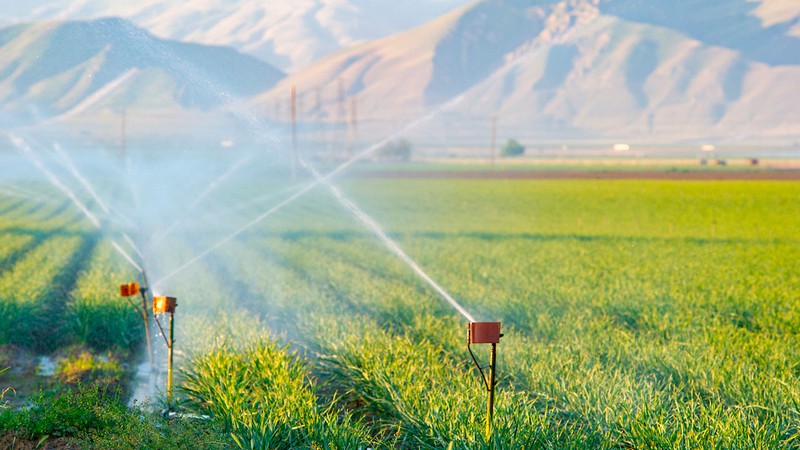Proposals were deemed inadequate for preventing dry wells and sinking land.

DWR’s report on groundwater sustainability plans was illustrated with this photograph of a wheat field irrigated by groundwater in the southern San Joaquin Valley. California Department of Water Resources
BY ALASTAIR BLAND , CalMatters
State water officials on March 2 rejected six local groundwater plans for the San Joaquin Valley, where basins providing drinking and irrigation water are severely depleted from decades of intensive pumping by farms.
The plans—submitted by local agencies tasked with the job of protecting underground supplies—outline strategies for complying with a state law requiring sustainable groundwater management.
The California Department of Water Resources deemed the plans inadequate because they “did not appropriately address deficiencies” in how water suppliers aimed to limit overdraft, land subsidence and impacts to drinking water wells.
Groundwater depletion has hurt the San Joaquin Valley’s small, rural communities, home to many low-income Latino residents who have been forced to live on bottled water and drill deeper wells, which can cost tens of thousands of dollars.
Another six local plans were approved, covering two groundwater basins in the Central Coast region and four in the San Joaquin Valley. Environmentalists and community activists say those plans are still likely to lead to more dried-up wells.
The long-awaited decisions by the Department of Water Resources mark a major step forward in implementing the state’s landmark 2014 Sustainable Groundwater Management Act. That law—considered a game changer in a state that had lacked statewide protection of groundwater—gives local agencies until 2040 to achieve groundwater sustainability.
The March 2 decisions came a year after the 12 plans were rejected as incomplete, largely for failing to adequately assess community impacts of groundwater pumping, mainly by farmers.
Most, if not all, of the approved and rejected plans allow groundwater levels to drop significantly before leveling off, according to Nataly Escobedo-Garcia, policy coordinator for the nonprofit group Leadership Counsel for Justice and Accountability.
Environmental and community justice groups in the San Joaquin Valley said some of the approved plans aren’t much better than their rejected prior renditions.
State law assigns local agencies the task of achieving sustainability, defined by several criteria, including chronic declines in groundwater levels, significant land subsidence, degraded water quality and saltwater intrusion.
For accepted plans, state officials will oversee implementation and evaluate their progress every five years.
Community water activist Tien Tran said she hopes the Department of Water Resources will steer the approved plans toward less impacts on communities.
“There still needs to be a lot more guidance from DWR on how to correct these problems even though the plans are already approved,” said Tran, a policy advocate with the group Community Water Center, which advocates for water equity.
The plans that were approved were for the Cuyama Basin in Santa Barbara, San Luis Obispo, Ventura and Kern counties; the Paso Robles Subbasin in San Luis Obispo County; the Eastern San Joaquin Subbasin in San Joaquin County; the Merced Subbasin in Merced County; the Westside Subbasin in Fresno and Kings counties; and the Kings Subbasin in Fresno County.
Escobedo-Garcia called on state water officials to stay vigilant as it oversees adoption and implementation of the approved plans.
The rejected plans will be handed over to the State Water Resources Control Board for further oversight: the Chowchilla Subbasin in Madera and Merced counties, the Delta-Mendota Subbasin in San Joaquin, Stanislaus, Merced, Fresno, Madera, and San Benito counties, the Kaweah Subbasin in Tulare and Kings counties, the Tule Subbasin in Tulare County, the Tulare Lake Subbasin in Kings County and the Kern Subbasin in Kern County.
These water managers have a minimum of a year to fix the inadequacies, according to Natalie Stork, a geologist with the State Water Resources Control Board’s Groundwater Management Program.
“If plans aren’t fixed, then the board will consider whether to develop and adopt an interim plan,” she said. An interim plan, she added, is a public process that will engage stakeholders.
The state is still reviewing another 61 plans for 59 of the state’s high- and medium-priority groundwater basins.
Visit CalMatters to read the full-length article, “State rejects local plans for protecting San Joaquin Valley groundwater,” as well as a translation into Spanish and links to related pieces.
CalMatters.org is a nonprofit, nonpartisan media venture explaining California policies and politics.